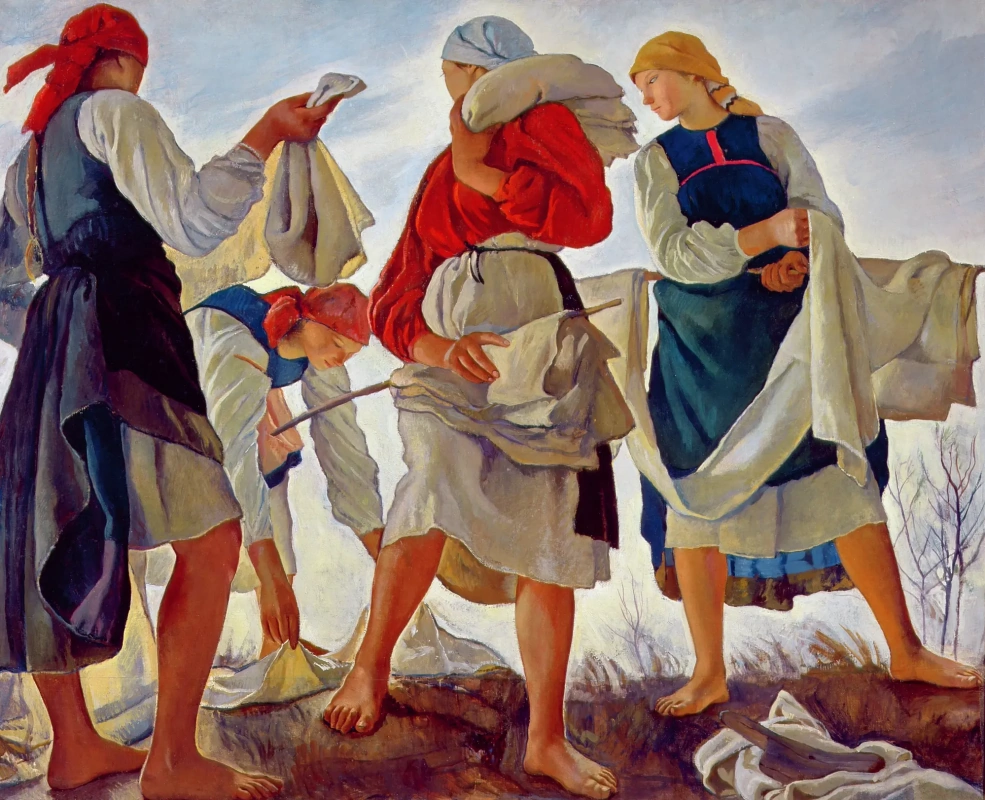log in
Enter site
Login to use Arthive functionality to the maximum
Blanchiment de la toile
Zinaida Serebryakova • Peinture, 1917, 141.8×173.6 cm


















Descriptif de la toile «Blanchiment de la toile»
Le blanchiment de la toile est un long processus. La toile tissée est initialement grise. Pour le rendre blanc comme neige, la toile s'est évaporée dans la liqueur, puis s'est étalée sur l'herbe pendant plusieurs jours. Il fallait le faire le matin ou le soir, car la toile devait être humide en permanence. La photo montre simplement le processus de pose de la toile.
Dans le musée russe est stocké un des croquis. Avant de passer à la version finale, Serebryakova a écrit de nombreux travaux préliminaires, les croquis ont été conservés (1, 2, 3).
Il est intéressant de voir comment la photo a changé pour la dernière incarnation. Sur la version du Musée russe devant nous, une histoire de ménage. Les paysannes travaillent sur la toile dans le contexte de la reconnaissable Neskuchny, dans laquelle Serebryakova a écrit ces œuvres. Dans l'image finale, l'artiste a abandonné le récit. L'histoire présentée sur "Toile blanchissante" de la galerie Tretiakov n’est pas sur la vie, mais a atteint un niveau monumental et archétypal. Les figures de femmes semblent énormes, elles couvrent tout le ciel, se détachant clairement sur son fond bleu pâle. Cet effet est obtenu grâce au fait que nous les voyons de bas en haut, ce qui rend les figures monumentales.
La coloration de la photo est laconique et construite sur l’échange rythmique de tons de rouge, de bleu, de blanc et de nuances, un coup de chapelet - pas de flirt avec l’impressionnisme. Si nous parlons du rôle artistique, il convient de rappeler sauffresques des maîtres de la Renaissance. Dans l'image finale, les paysannes ne semblent pas du tout être des paysannes au travail, elles semblent être des déesses, pas seulement en train de blanchir la toile, mais en créant le monde entier. Bien ou au moins la voie lactée.
Cependant, avec cette analogie, les jambes joliment écrites des femmes entrent en dissonance: force à la fois élégante et élégante, sombre, pénétrée de soleil et rayonnante d'un jeune corps - très réel, humain, féminin.
L’image des paysans est l’un des thèmes clés de Zinaida Serebryakova, au même titre que les portraits de famille et simplement les portraits, les nus et les ballerines. «Blanchiment de la toile» est la plus haute réalisation de ce thème dans le travail de l’artiste.
Serebryakova entretenait une relation chaleureuse avec ses modèles paysans. Lorsque la révolution a commencé, ce sont leurs paysans qui ont averti Serebryakov qu'ils se préparaient à incendier leurs terres. Et quand son mari est décédé, le transfert des paysans a souvent permis à Zinaida Serebryakova et ses enfants à Kharkov de survivre pendant cette période de famine.
Auteur: Alena Esaulova
Dans le musée russe est stocké un des croquis. Avant de passer à la version finale, Serebryakova a écrit de nombreux travaux préliminaires, les croquis ont été conservés (1, 2, 3).
Il est intéressant de voir comment la photo a changé pour la dernière incarnation. Sur la version du Musée russe devant nous, une histoire de ménage. Les paysannes travaillent sur la toile dans le contexte de la reconnaissable Neskuchny, dans laquelle Serebryakova a écrit ces œuvres. Dans l'image finale, l'artiste a abandonné le récit. L'histoire présentée sur "Toile blanchissante" de la galerie Tretiakov n’est pas sur la vie, mais a atteint un niveau monumental et archétypal. Les figures de femmes semblent énormes, elles couvrent tout le ciel, se détachant clairement sur son fond bleu pâle. Cet effet est obtenu grâce au fait que nous les voyons de bas en haut, ce qui rend les figures monumentales.
La coloration de la photo est laconique et construite sur l’échange rythmique de tons de rouge, de bleu, de blanc et de nuances, un coup de chapelet - pas de flirt avec l’impressionnisme. Si nous parlons du rôle artistique, il convient de rappeler sauffresques des maîtres de la Renaissance. Dans l'image finale, les paysannes ne semblent pas du tout être des paysannes au travail, elles semblent être des déesses, pas seulement en train de blanchir la toile, mais en créant le monde entier. Bien ou au moins la voie lactée.
Cependant, avec cette analogie, les jambes joliment écrites des femmes entrent en dissonance: force à la fois élégante et élégante, sombre, pénétrée de soleil et rayonnante d'un jeune corps - très réel, humain, féminin.
L’image des paysans est l’un des thèmes clés de Zinaida Serebryakova, au même titre que les portraits de famille et simplement les portraits, les nus et les ballerines. «Blanchiment de la toile» est la plus haute réalisation de ce thème dans le travail de l’artiste.
Serebryakova entretenait une relation chaleureuse avec ses modèles paysans. Lorsque la révolution a commencé, ce sont leurs paysans qui ont averti Serebryakov qu'ils se préparaient à incendier leurs terres. Et quand son mari est décédé, le transfert des paysans a souvent permis à Zinaida Serebryakova et ses enfants à Kharkov de survivre pendant cette période de famine.
Auteur: Alena Esaulova


